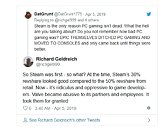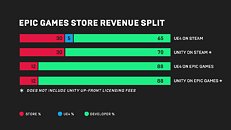Monday, April 8th 2019

"Steam Was Killing PC Gaming", Former Valve Dev Says
The EPIC confrontation with Valve has become a hot topic in recent months, as a veritable Exodus of titles have migrated to the greener, 12%-limited cut that the EPIC Games Store takes from publishers who put their games on the EPIC Games Store digital storefront. Mostly, user reception of EPIC's practice of securing mostly one-year timed exclusivity deals for games that would otherwise also be available through Steam has left a sour taste oin gamers' mouths, as it is seen as a forced way for EPIC to fracture the PC gaming space.
However, a former Valve developer has come forth to say that in his view, Valve's 30% cut was already way behind the times, and was actually "killing PC gaming". The train of thought is that Steam itself changed Valve from a software company to what mostly amounts to a service provider, with Steam serving as a veritable digital money printing machine, that stole focus from games to games publishing, due to higher margins and much lower development costs. It's interesting - and logical - to assume that the reason an Half Life 3 never saw the light of day was because Valve had its revenue stream well secured in Steam. Why invest for a game that could be a flop, when you can just take a 30% cut from other developers' efforts?Of course, the argument does make some sense. At the same time, it's true that Valve's Steam platform did advance gaming for publishers more than is being let on - a 40% royalty on digitally published games beat the usually 50% take that brick-and-mortar stores usually took in order to reserve shelf space for a new game release. However, as times changed and digital publishing became more commonplace (and game development costs rise and rise), it's understandable that a 30% cut was hitting a new sustainability ceiling for developers. And that's where Richard Geldreich's argument makes more sense: a 12% cut will allow for developers to invest more heavily into their games due to the much reduced revenue cut they have to take into account on projected sales.That, or they'll invest the same amount of money and take a deeper cut for investors. It could go both ways.
Source:
@Richard Geldreich's Twitter
However, a former Valve developer has come forth to say that in his view, Valve's 30% cut was already way behind the times, and was actually "killing PC gaming". The train of thought is that Steam itself changed Valve from a software company to what mostly amounts to a service provider, with Steam serving as a veritable digital money printing machine, that stole focus from games to games publishing, due to higher margins and much lower development costs. It's interesting - and logical - to assume that the reason an Half Life 3 never saw the light of day was because Valve had its revenue stream well secured in Steam. Why invest for a game that could be a flop, when you can just take a 30% cut from other developers' efforts?Of course, the argument does make some sense. At the same time, it's true that Valve's Steam platform did advance gaming for publishers more than is being let on - a 40% royalty on digitally published games beat the usually 50% take that brick-and-mortar stores usually took in order to reserve shelf space for a new game release. However, as times changed and digital publishing became more commonplace (and game development costs rise and rise), it's understandable that a 30% cut was hitting a new sustainability ceiling for developers. And that's where Richard Geldreich's argument makes more sense: a 12% cut will allow for developers to invest more heavily into their games due to the much reduced revenue cut they have to take into account on projected sales.That, or they'll invest the same amount of money and take a deeper cut for investors. It could go both ways.




98 Comments on "Steam Was Killing PC Gaming", Former Valve Dev Says
That's why I went from pirating in my teens to buying games.
Those millions of users must be bots, too.
It's been awhile already, and we still have no new features in Epic store. None whatsoever. I don't think it changed at all since it was launched as a storefront for UE-based games many-many moons ago, except now it has lots of in-yo-face pictures and "pre-order now" and "coming soon" all over the place.
trello.com/b/GXLc34hk/epic-games-store-roadmap
They likely have to add a new column to their databases which reflect the revenue share Valve keeps, applying a default of 30% to everything. Then they have to update their contracts so new products get an updated rate which is reflected in the databases. Then they have to do a trial run to make sure everything works from start to finish. Then they have to start signing people at the new rate.
The change they made in December really complicated things in the back end because everyone that applies to must still get it. They're probably trying to bake that into the updated code too.
In theory, they should be able to get it done in a week, but in practice, they can't afford any mistakes.
Galyonkin has been crawling and data-mining Steam for nearly 4 years, and the end-result is a miserable landing page with a bunch of pictures, and a game client which basically shows you their web front-end after login.
Regarding regional pricing - they are using XSolla, same as steam in most regions, only for Epic it's the only payment system(for now, I guess). Conversion is automatic. Pricing on the storefront is adjusted via a couple of API calls. Transactions are handled exactly the same way for any currency.
They were too lazy to implement it off the start (or too busy negotiating timed exclusives). It's kind of back-ass-ackwards approach to the general "store" notion. Instead of "clients first" and "users must be happy", they go with "suppliers first, users can wait".
Achievements and Shopping cart by 2020? My beard will turn grey by then.
I can only imagine the bandwith cost of all those Steam keys sold on other storefronts. They actually lose money on those.
btw I'm not advocating for anyone to sign up for an account on the Epic store right now. I'm certainly not going to until they have proven that they will maintain their store properly. I did the same with Steam, GOG, Origin, Uplay and MS Store when all of those stores launched.
Just not timed exclusive, differentiate with price exclusives , there's a consumer friendly and enticing plan, ill buy no exclusive despite having the epic store installed.
Don't get me wrong: competition is good, options are good, good options are even better... but strongarming userbase into committing to a pathetic half-assed platform by paying off timed exclusives is not the right thing for us - consumers. Maybe it's fair[-er] to devs, but we are the ones paying their bills.
Epic essentially just did what Steam did so long ago; offer a smaller chunk of the profits be taken out. Steam took the ~50% of storefront sales to 30%; now Epic is doing to them what they did back then, they'll either compete, or wither away slowly.
If I were Valve, I'd drop my percentage to match Epic store, then I'd get devs to work on implementing a way for Steam to integrate the launch process for any other storefront launcher natively and offer to charge a nominal fee to the other storefronts for this integration. Not only does that bring the pricing of your service in line with what will become the standard, it also incentivizes the other storefronts to pay for the integration because it will appease the consumers. Valve wins, consumers win (sort of), and they get some good PR for making an attempt at doing something like that. It's not exactly a fair strategy, as any storefront that refused to be a part of it would get lynched hard, so Valve would have a powerful (maybe too powerful) weapon with that strategy.